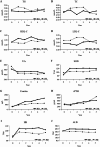Association between time-varying serum lipid levels and all-cause mortality in haemodialysis and peritoneal dialysis patients
- PMID: 40253357
- PMCID: PMC12008947
- DOI: 10.1186/s12882-025-04119-x
Association between time-varying serum lipid levels and all-cause mortality in haemodialysis and peritoneal dialysis patients
Abstract
Objective: Changes in lipid levels over time and the associated all-cause mortality have not yet been studied in different populations of patients undergoing dialysis. This study aimed to investigate the differences in time-varying serum lipid levels and all-cause mortality among haemodialysis (HD) and peritoneal dialysis (PD) patients over a 5-year follow-up period.
Methods: This observational study included Chinese patients with end-stage renal disease (ESRD) who started HD or PD at Sun Yat-sen Memorial Hospital from January 2010 to February 2018. Changes in lipid profiles and trends of change in overall survival rates between the two groups were investigated. Risk factors for the outcome were identified, and the optimal cut-off values were determined using ROC analysis. Additionally, the relationship between the group variable and the outcome measure was assessed using linear regression with a generalized estimating equation (GEE) model.
Results: A total of 141 patients (74 HD patients and 67 PD patients) were enrolled in the study. Forty-three (30.71%) patients died during the follow-up period. Compared with the HD group, the PD group had significantly greater triglyceride (TG) (Year 1 and Year 2) and low-density lipoprotein cholesterol (LDL-C) (Year 2) levels and significantly lower high-density lipoprotein cholesterol (HDL-C) (Year 1 and Year 2) levels. There was no significant difference in total cholesterol (TC) levels. The GEE results revealed similar changes in lipid levels between HD patients and PD patients over time. The Kaplan‒Meier survival curve revealed that there was no significant difference in overall survival between the two groups (log-rank test, P = 0.119). Furthermore, the multivariate Cox proportional hazard regression models demonstrated that baseline HDL-C levels (HR: 0, 95% CI: 0 to 0.11; P = 0.004) and changes in LDL-C levels from baseline to 3 years of follow-up(difference from 0 to 3 years of follow-up) (HR: 0.21, 95% CI: 0.09 to 0.53; P < 0.001) were associated with a greater risk of death in HD patients. An increase in LDL-C levels (difference from 0 to 3 years of follow-up) ≤ 0.24 mmol/L in HD patients and age ≥ 53 years in all patients initiating dialysis was associated with a significantly increased risk of mortality.
Conclusion: The baseline levels of HDL-C and changes in LDL-C levels over a three-year period were significant predictors of all-cause mortality in HD patients, which differed from the lack of significant risk factors observed in the PD group.
Keywords: Haemodialysis; Lipid; Mortality; Peritoneal dialysis; Time-varying.
© 2025. The Author(s).
Conflict of interest statement
Declarations. Ethics approval and consent to participate: The study followed the tenets of the Declaration of Helsinki, and informed consent was obtained from all the participants. The study was approved by the institutional review board of Sun Yat-sen Memorial Hospital of Sun Yat-sen University, Guangzhou, China (SYSKY-2024-860-01). Clinical trial number: Not applicable. Competing interests: The authors declare no competing interests.
Figures




Similar articles
-
Comparing Dialysis Modality and Cardiovascular Mortality in Patients on Hemodialysis and Peritoneal Dialysis.Adv Perit Dial. 2016;32:22-31. Adv Perit Dial. 2016. PMID: 28988586
-
The association between the atherogenic index of plasma and all-cause mortality in patients undergoing peritoneal dialysis: a multicenter cohort study.Lipids Health Dis. 2025 Mar 13;24(1):91. doi: 10.1186/s12944-025-02510-z. Lipids Health Dis. 2025. PMID: 40082960 Free PMC article.
-
Higher Serum Total Cholesterol to High-Density Lipoprotein Cholesterol Ratio Is Associated with Increased Mortality among Incident Peritoneal Dialysis Patients.Nutrients. 2021 Dec 29;14(1):144. doi: 10.3390/nu14010144. Nutrients. 2021. PMID: 35011019 Free PMC article.
-
Statins for treatment of dyslipidemia in chronic kidney disease.Perit Dial Int. 2006 Sep-Oct;26(5):523-39. Perit Dial Int. 2006. PMID: 16973506 Review.
-
Impact of peritoneal dialysis and hemodialysis on mortality in patients with end-stage renal disease: A systematic review and meta-analysis.Ther Apher Dial. 2025 Feb;29(1):79-88. doi: 10.1111/1744-9987.14195. Epub 2024 Aug 26. Ther Apher Dial. 2025. PMID: 39187465
References
-
- Qunibi WY. Dyslipidemia in dialysis patients. Semin Dial. 2015 Jul-Aug;28(4):345– 53. - PubMed
-
- Tingting G, Wenqi X, Huanqing G, Jijuan Z, Jiaojiao Z, Kaiyue W, et al. Relationship between control of cardiovascular risk factors and chronic kidney disease progression, cardiovascular disease events, and mortality in Chinese adults. J Am Coll Cardiol. 2024;84(14). - PubMed
Publication types
MeSH terms
Substances
LinkOut - more resources
Full Text Sources
Medical
Miscellaneous

